Related Research Articles

Jacob Ludwig Karl Grimm, also known as Ludwig Karl, was a German author, linguist, philologist, jurist, and folklorist. He formulated Grimm's law of linguistics, and was the co-author of the Deutsches Wörterbuch, the author of Deutsche Mythologie, and the editor of Grimms' Fairy Tales. He was the older brother of Wilhelm Grimm; together, they were the literary duo known as the Brothers Grimm.
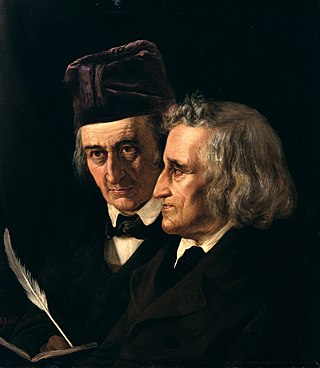
The Brothers Grimm, Jacob (1785–1863) and Wilhelm (1786–1859), were German academics who together collected and published folklore. The brothers are among the best-known storytellers of folktales, popularizing stories such as "Cinderella", "The Frog Prince", "Hansel and Gretel", "Little Red Riding Hood", "Rapunzel", "Rumpelstiltskin", "Sleeping Beauty", and "Snow White". Their first collection of folktales, Children's and Household Tales, began publication in 1812.

"Bluebeard" is a French folktale, the most famous surviving version of which was written by Charles Perrault and first published by Barbin in Paris in 1697 in Histoires ou contes du temps passé. The tale tells the story of a wealthy man in the habit of murdering his wives and the attempts of the present one to avoid the fate of her predecessors. "The White Dove", "The Robber Bridegroom", and "Fitcher's Bird" are tales similar to "Bluebeard". The notoriety of the tale is such that Merriam-Webster gives the word "Bluebeard" the definition of "a man who marries and kills one wife after another". The verb "bluebearding" has even appeared as a way to describe the crime of either killing a series of women, or seducing and abandoning a series of women.

"Rapunzel" is a European fairy tale most notably recorded by the Brothers Grimm and published in 1812 as part of Children's and Household Tales. The Brothers Grimm's story was developed from the French literary fairy tale of Persinette by Charlotte-Rose de Caumont de La Force (1698), which itself is an alternative version of the Italian fairy tale Petrosinella by Giambattista Basile.
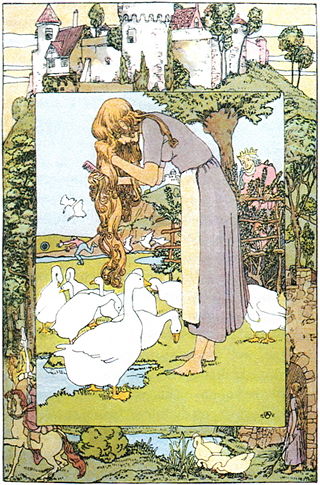
"The Goose Girl" is a German fairy tale collected by the Brothers Grimm and first published in Grimm's Fairy Tales in 1815. It is of Aarne-Thompson type 533.

Grimms' Fairy Tales, originally known as the Children's and Household Tales, is a German collection of fairy tales by the Grimm brothers or "Brothers Grimm", Jacob and Wilhelm, first published on 20 December 1812. Vol. 1 of the first edition contained 86 stories, which were followed by 70 more tales, numbered consecutively, in the 1st edition, Vol. 2, in 1815. By the seventh edition in 1857, the corpus of tales had expanded to 200 tales and 10 "Children's Legends". It is listed by UNESCO in its Memory of the World Registry.
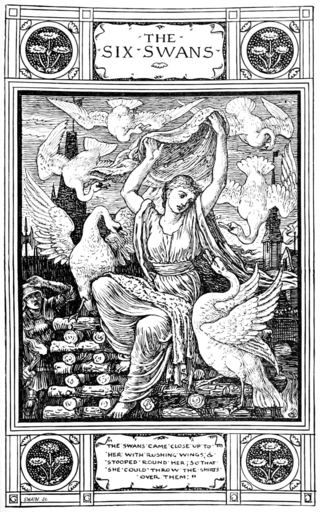
"The Six Swans" is a German fairy tale collected by the Brothers Grimm in Grimm's Fairy Tales in 1812. It is of Aarne–Thompson type 451, commonly found throughout Europe. Other tales of this type include The Seven Ravens, The Twelve Wild Ducks, Udea and her Seven Brothers, The Wild Swans, and The Twelve Brothers. Andrew Lang included a variant of the tale in The Yellow Fairy Book.
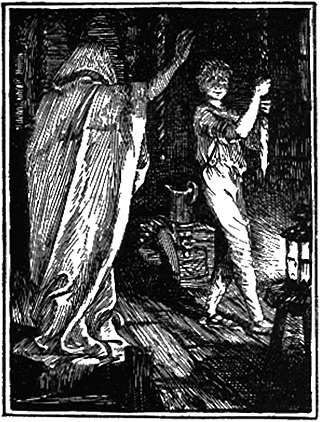
"The Story of the Youth Who Went Forth to Learn What Fear Was" or "The Story of a Boy Who Went Forth to Learn Fear" is a German folktale collected by the Brothers Grimm in Grimm's Fairy Tales. The tale was also included by Andrew Lang in The Blue Fairy Book (1889).
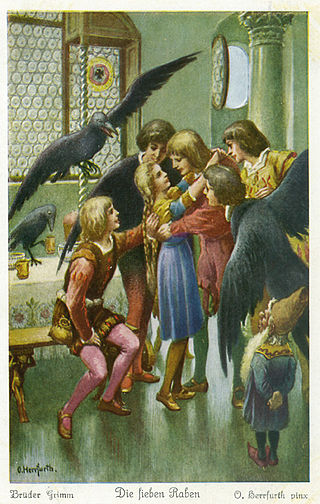
"The Seven Ravens" is a German fairy tale collected by the Brothers Grimm. It is of Aarne–Thompson type 451, commonly found throughout Europe.

"The Juniper Tree" is a German fairy tale published in Low German by the Brothers Grimm in Grimm's Fairy Tales in 1812. The story contains themes of child abuse, murder, cannibalism and biblical symbolism and is one of the Brothers Grimm's darker and more mature fairy tales.
"The Thief and His Master" is a German fairy tale collected by the Brothers Grimm in Grimm's Fairy Tales as tale number 68. In the first edition there was another fairy tale at place 68. The name of the fairy tale is "Von dem Sommer- und Wintergarten".
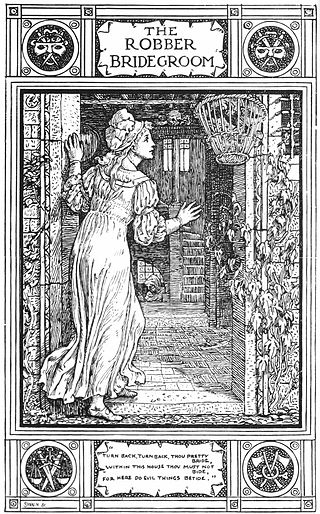
"The Robber Bridegroom" is a German fairy tale collected by the Brothers Grimm, tale number 40. Joseph Jacobs included a variant, Mr Fox, in English Fairy Tales, but the original provenance is much older; Shakespeare alludes to the Mr. Fox variant in Much Ado About Nothing, Act 1, Scene 1:

"The Wolf and the Seven Young Goats" is a fairy tale collected by the Brothers Grimm and published in Grimm's Fairy Tales. It is of Aarne-Thompson type 123 "The Wolf and the Kids".
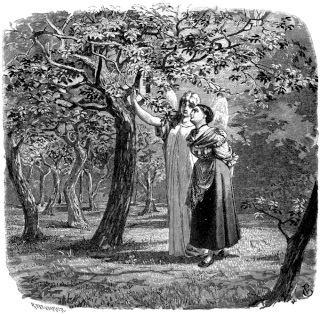
"The Girl Without Hands" or "The helpless Maiden" or "The Armless Maiden" is a German fairy tale collected by the Brothers Grimm. It is tale number 31 and was first published in the 1812 edition of Children's and Household Tales. The story was revised by the Grimm brothers over the years, and the final version was published in the 7th edition of Children's and Household Tales in 1857. It is Aarne-Thompson type 706.

"Cat and Mouse in Partnership" is a German fairy tale collected by the Brothers Grimm in Grimms' Fairy Tales. It is a story of Aarne-Thompson type 15.
"Thumbling," published in German as "Daumesdick" is a German fairy tale collected by the Brothers Grimm in Grimm's Fairy Tales in 1819. The Grimms included another, similar story, "Thumbling's Travels." Both stories are related to the English Tom Thumb and often share its title when translated into English.
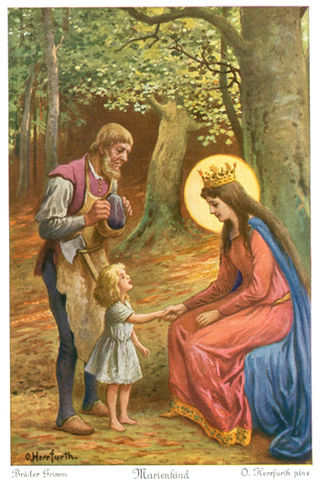
"Mary's Child" is a German fairy tale collected by the Brothers Grimm in Grimm's Fairy Tales in 1812. It is of Aarne-Thompson type 710.
"The Golden Key" is a fairy tale, which is in place 200 of Grimms' Fairy Tales.
"The Maid of Brakel" is a German fairy tale collected by the Brothers Grimm in Grimms' Fairy Tales, tale number 115.
"Thumbling's Travels" is a German fairy tale collected by the Brothers Grimm in Grimm's Fairy Tales in 1812. The original German name for the character is "Daumerling," not to be confused with the similar tale "Daumesdick" or KHM 37, which was added in 1819. Both tales are frequently translated into English as "Tom Thumb" or "Thumbling" and are categorized as Aarne-Thompson type 700.
References
- ↑ Jacob and Wilheim Grimm, Household Tales, "The Fox and the Geese"
- ↑ D.L. Ashliman, "The Grimm Brothers' Children's and Household Tales (Grimms' Fairy Tales)"